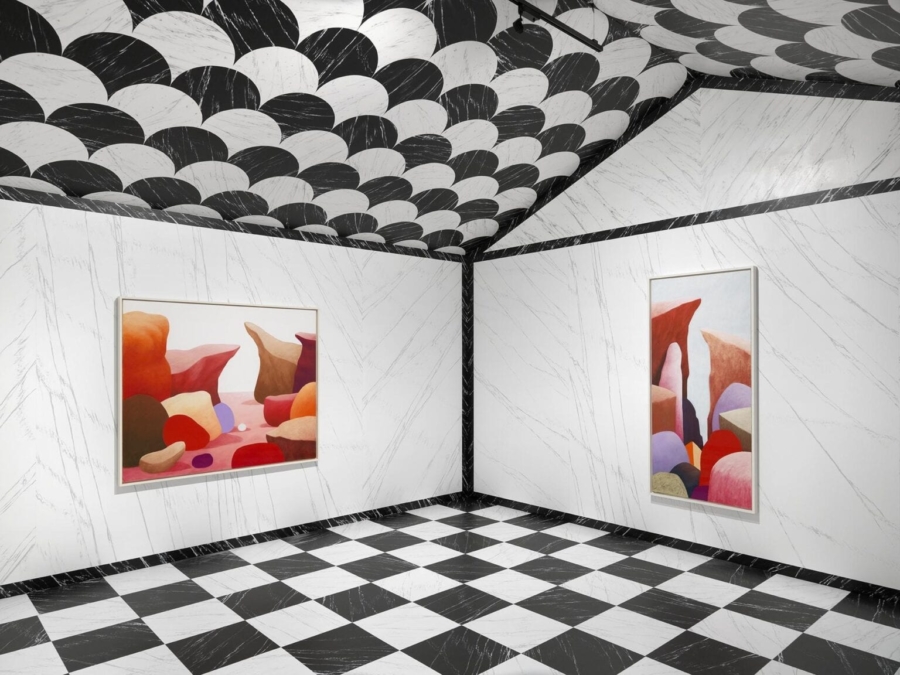June 28, 2021
Download as PDF
View on Politicamente Corretto

Nicolas Party “Ruins,” MASI Lugano. View of the exhibition. Photo Annik Wetter © Nicolas Party
From 27 June 2021 to 9 January 2022 the Art Museum of Italian Switzerland presents “Ruins”, the first major monographic exhibition by Nicolas Party (Lausanne, 1980) in a European museum. In this immersive project, the artist has created an alienating universe, characterized by bold color contrasts, enveloping architectural forms and unexpected trompe l’œil decorations, within which his magnetic works are staged: large site murals, specific, intriguing polychrome sculptures, and bright pastel paintings.
This ambitious exhibition project was conceived by the artist expressly in relation to the structure of the large exhibition hall located in the basement of MASI, in the headquarters of the LAC cultural center, where an imposing architectural plan arose: the space is divided into five distinct environments, each of which is dedicated to a recurring theme in Nicolas Party’s work: still life, portrait, rocky views, caves and landscape.
Outside this structure Party has created four large pastel wall paintings inspired by Arnold Böcklin (a Swiss painter and one of the leading exponents of symbolism) depicting enigmatic views of decaying buildings refered to in exhibition title. These monochrome and decadent scenarios welcome the viewer into an environment in stark contrast to the chromatic riot that distinguishes the works. As is his custom, the artist has in fact further modified the exhibition space through backgrounds of contrasting colors and trompe l’œil polychrome marble decorations, created in collaboration with Sarah Margnetti. This presentation typifies Party’s thinking.
The exhibition features thirty-one pastel paintings and four painted sculptures (one of which is outside the museum), which were created between 2013 and today, and some of which are being presented for the first time to the public. This careful selection highlights the artist’s preference for an extremely lively chromatic range and simplified figuration. His subjects are outlined by circumscribed and contrasting color backgrounds, according to a strategy that can be partly traced back to his singular artistic apprenticeship, which began with the creation of graffiti.
Party’s compositions are not born from the observation of real data (he does not use models and does not create landscapes en plein air), but are exclusively the result of his imagination. They are characterized by an extremely simple setting and without any temporal or environmental reference. Although his subjects have no direct relationship with reality, they contain in their essential forms the lowest common denominator that leads the viewer to associate them with clearly recognizable entities such as faces, fruits or trees. And it is precisely the possibility of elaborating a universal and timeless language that fascinates Party and guides his artistic research.
Party places his creative universe in constant dialogue with the history of art, of which he is an attentive and tireless explorer. If in his paintings it is easy to hear the echo of the disturbing étrangeté of surrealist painting or of the chromatic choices of the Fauves, the artist’s references range far beyond, from the search for an ideal perfection of classical art, to the scientific minutia of nature Dutch death of the seventeenth century. Party also became passionate about the work of famous artists such as Georgia O’Keeffe (1887-1986) or Ferdinand Hodler (1853-1918), as well as that of lesser-known figures, such as the Belgian symbolist William Degouve de Nuncques (1867 -1935) or the portraitist Rosalba Carriera (1675-1757), whose name is inextricably linked to the history of pastel–Nicolas Party’s favorite medium.



